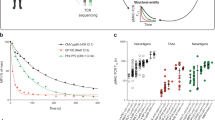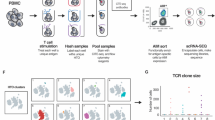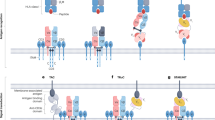Abstract
While for certain cancers, such as cervical cancer, the link to viral infections is very strong and very clear, other cancers represent a history of links to viral infections that are either co-morbidities or drive the cancer in ways that are not yet fully understood, for example the “hit and run” possibility. To further understand the connection of viral infections and the progress of breast cancer, we identified the chemical features of known anti-viral, T-cell receptor alpha chain (TRA) complementarity determining region-3 (CDR3) amino acid sequences among the CDR3s of breast cancer patient TRA recombinations and assessed the association of those features with patient outcomes. The application of this novel paradigm indicated consistent associations of tumor-derived, anti-CMV CDR3 chemical sequence motifs with better breast cancer patient outcomes but did not indicate an opportunity to establish risk stratifications for other cancer types. Interestingly, breast cancer samples with no detectable TRA recombinations represented a better outcome than samples with the non-anti-CMV CDR3s, further adding to a rapidly developing series of results allowing a distinction between positive and possibly harmful cancer immune responses.
This is a preview of subscription content, access via your institution
Access options
Subscribe to this journal
Receive 6 digital issues and online access to articles
$119.00 per year
only $19.83 per issue
Buy this article
- Purchase on Springer Link
- Instant access to full article PDF
Prices may be subject to local taxes which are calculated during checkout




Similar content being viewed by others
Data availability
All data used in the analyses for this report are available in the SOM; and as publicly available information at cbioportal.org.
References
Crosbie EJ, Einstein MH, Franceschi S, Kitchener HC. Human papillomavirus and cervical cancer. Lancet. 2013;382:889–99.
Bosch FX, Munoz N. The viral etiology of cervical cancer. Virus Res. 2002;89:183–90.
Okunade KS. Human papillomavirus and cervical cancer. J Obstet Gynaecol. 2020;40:602–8.
Sand FL, Kjaer SK, Frederiksen K, Dehlendorff C. Risk of cervical intraepithelial neoplasia grade 2 or worse after conization in relation to HPV vaccination status. Int J cancer J Int du cancer. 2020;147:641–7.
Walboomers JM, Jacobs MV, Manos MM, Bosch FX, Kummer JA, Shah KV, et al. Human papillomavirus is a necessary cause of invasive cervical cancer worldwide. J Pathol. 1999;189:12–9.
Mahieux R, Gessain A. HTLV-1 and associated adult T-cell leukemia/lymphoma. Rev Clin Exp Hematol. 2003;7:336–61.
Giam CZ, Semmes OJ. HTLV-1 Infection and Adult T-Cell Leukemia/Lymphoma-A Tale of Two Proteins: Tax and HBZ. Viruses. 2016;8:161.
Azran I, Schavinsky-Khrapunsky Y, Aboud M. Role of Tax protein in human T-cell leukemia virus type-I leukemogenicity. Retrovirology. 2004;1:20.
Matsuoka M, Jeang KT. Human T-cell leukemia virus type 1 (HTLV-1) and leukemic transformation: viral infectivity, Tax, HBZ and therapy. Oncogene. 2011;30:1379–89.
Satou A, Nakamura S. EBV-positive B-cell lymphomas and lymphoproliferative disorders: Review from the perspective of immune escape and immunodeficiency. Cancer Med. 2021;10:6777–85.
Xie Y. Hepatitis B virus-associated hepatocellular carcinoma. Adv Exp Med Biol. 2017;1018:11–21.
Shin EC, Sung PS, Park SH. Immune responses and immunopathology in acute and chronic viral hepatitis. Nat Rev Immunol. 2016;16:509–23.
Levrero M, Zucman-Rossi J. Mechanisms of HBV-induced hepatocellular carcinoma. J Hepatol. 2016;64:S84–S101.
Irshad M, Gupta P, Irshad K. Molecular basis of hepatocellular carcinoma induced by hepatitis C virus infection. World J Hepatol. 2017;9:1305–14.
Zamor PJ, deLemos AS, Russo MW. Viral hepatitis and hepatocellular carcinoma: Etiology and management. J Gastrointest Oncol. 2017;8:229–42.
Fung J, Lai CL, Yuen MF. Hepatitis B and C virus-related carcinogenesis. Clin Microbiol Infect. 2009;15:964–70.
Teo WH, Chen HP, Huang JC, Chan YJ. Human cytomegalovirus infection enhances cell proliferation, migration and upregulation of EMT markers in colorectal cancer-derived stem cell-like cells. Int J Oncol. 2017;51:1415–26.
Cao Y, Xie L, Shi F, Tang M, Li Y, Hu J, et al. Targeting the signaling in Epstein-Barr virus-associated diseases: Mechanism, regulation, and clinical study. Signal Transduct Target Ther. 2021;6:15.
Min BH, Tae CH, Ahn SM, Kang SY, Woo SY, Kim S, et al. Epstein-Barr virus infection serves as an independent predictor of survival in patients with lymphoepithelioma-like gastric carcinoma. Gastric Cancer. 2016;19:852–9.
Lawson JS, Salmons B, Glenn WK. Oncogenic Viruses and Breast Cancer: Mouse Mammary Tumor Virus (MMTV), Bovine Leukemia Virus (BLV), Human Papilloma Virus (HPV), and Epstein-Barr Virus (EBV). Front Oncol. 2018;8:1.
Marrao G, Habib M, Paiva A, Bicout D, Fallecker C, Franco S, et al. Epstein-Barr virus infection and clinical outcome in breast cancer patients correlate with immune cell TNF-alpha/IFN-gamma response. BMC cancer. 2014;14:665.
Cinatl J Jr., Vogel JU, Kotchetkov R, Wilhelm Doerr H. Oncomodulatory signals by regulatory proteins encoded by human cytomegalovirus: A novel role for viral infection in tumor progression. FEMS Microbiol Rev. 2004;28:59–77.
Maussang D, Verzijl D, van Walsum M, Leurs R, Holl J, Pleskoff O, et al. Human cytomegalovirus-encoded chemokine receptor US28 promotes tumorigenesis. Proc Natl Acad Sci USA. 2006;103:13068–73.
Cai ZZ, Xu JG, Zhou YH, Zheng JH, Lin KZ, Zheng SZ, et al. Human cytomegalovirus-encoded US28 may act as a tumor promoter in colorectal cancer. World J Gastroenterol. 2016;22:2789–98.
Gru AA, Haverkos BH, Freud AG, Hastings J, Nowacki NB, Barrionuevo C, et al. The Epstein-Barr Virus (EBV) in T Cell and NK Cell Lymphomas: Time for a Reassessment. Curr Hematol Malig Rep. 2015;10:456–67.
Cai Q, Chen K, Young KH. Epstein-Barr virus-positive T/NK-cell lymphoproliferative disorders. Exp Mol Med. 2015;47:e133.
Hu H, Luo ML, Desmedt C, Nabavi S, Yadegarynia S, Hong A, et al. Epstein-Barr virus infection of mammary epithelial cells promotes malignant transformation. EBioMedicine. 2016;9:148–60.
Valle Oseguera CA, Spencer JV. Human cytomegalovirus interleukin-10 enhances matrigel invasion of MDA-MB-231 breast cancer cells. Cancer cell Int. 2017;17:24.
Shaimerdenova M, Karapina O, Mektepbayeva D, Alibek K, Akilbekova D. The effects of antiviral treatment on breast cancer cell line. Infect Agent Cancer. 2017;12:18.
Zaman S, Chobrutskiy BI, Patel JS, Diviney A, Tu YN, Tong WL, et al. Antiviral T cell receptor complementarity determining region-3 sequences are associated with a worse cancer outcome: A pancancer analysis. Viral Immunol. 2020;33:404–12.
Bagaev DV, Vroomans RMA, Samir J, Stervbo U, Rius C, Dolton G, et al. VDJdb in 2019: Database extension, new analysis infrastructure and a T-cell receptor motif compendium. Nucleic acids Res. 2020;48(D1):D1057–62.
Gill TR, Samy MD, Butler SN, Mauro JA, Sexton WJ, Blanck G. Detection of productively rearranged TcR-alpha V-J sequences in TCGA exome files: Implications for tumor immunoscoring and recovery of antitumor T-cells. Cancer Inf. 2016;15:23–8.
Samy MD, Tong WL, Yavorski JM, Sexton WJ, Blanck G. T cell receptor gene recombinations in human tumor specimen exome files: Detection of T cell receptor-beta VDJ recombinations associates with a favorable oncologic outcome for bladder cancer. Cancer Immunol, immunotherapy: CII. 2017;66:403–10.
Patel DN, Yeagley M, Arturo JF, Falasiri S, Chobrutskiy BI, Gozlan EC, et al. A comparison of immune receptor recombination databases sourced from tumour exome or RNAseq files: Verifications of immunological distinctions between primary and metastatic melanoma. Int J Immunogenet. 2021;48:409–18.
Chobrutskiy BI, Zaman S, Tong WL, Diviney A, Blanck G. Recovery of T-cell receptor V(D)J recombination reads from lower grade glioma exome files correlates with reduced survival and advanced cancer grade. J Neurooncol. 2018;140:697–704.
Chobrutskiy A, Chobrutskiy BI, Zaman S, Hsiang M, Blanck G. Chemical features of blood-borne TRG CDR3s associated with an increased overall survival in breast cancer. Breast cancer Res Treat. 2021;185:591–600.
Tong WL, Callahan BM, Tu YN, Zaman S, Chobrutskiy BI, Blanck G. Immune receptor recombinations from breast cancer exome files, independently and in combination with specific HLA alleles, correlate with better survival rates. Breast Cancer Res Treat. 2019;173:167–77.
Clark KR, Tong WL, Callahan BM, Yavorski JM, Tu YN, Blanck G. TRB-J1 usage, in combination with the HLA-A*01:01 allele, represents an apparent survival advantage for uterine corpus endometrial carcinoma: Comparisons with microscopic assessments of lymphocyte infiltrates. Int J Immunogenet. 2019;46:31–37.
Patel AR, Patel DN, Tu YN, Yeagley M, Chobrutskiy A, Chobrutskiy BI et al. Chemical complementarity between immune receptor CDR3s and candidate cancer antigens correlating with reduced survival: evidence for outcome mitigation with corticosteroid treatments. J Biomol Struct Dyn. 2022; 1–9. https://doi.org/10.1080/07391102.2022.2070546.
Hillen F, Baeten CI, van de Winkel A, Creytens D, van der Schaft DW, Winnepenninckx V, et al. Leukocyte infiltration and tumor cell plasticity are parameters of aggressiveness in primary cutaneous melanoma. Cancer Immunol, immunotherapy: CII. 2008;57:97–106.
Richardson AK, Currie MJ, Robinson BA, Morrin H, Phung Y, Pearson JF, et al. Cytomegalovirus and Epstein-Barr virus in breast cancer. PloS one. 2015;10:e0118989.
Nehme Z, Pasquereau S, Haidar Ahmad S, El Baba R, Herbein G. Polyploid giant cancer cells, EZH2 and Myc upregulation in mammary epithelial cells infected with high-risk human cytomegalovirus. EBioMedicine. 2022;80:104056.
Herbein G. High-Risk Oncogenic Human Cytomegalovirus. Viruses. 2022;14:2462.
Soderberg-Naucler C. New mechanistic insights of the pathogenicity of high-risk cytomegalovirus (CMV) strains derived from breast cancer: Hope for new cancer therapy options. EBioMedicine. 2022;81:104103.
Jung K, Son MJ, Lee SY, Kim JA, Ko DH, Yoo S, et al. Antibody-mediated delivery of a viral MHC-I epitope into the cytosol of target tumor cells repurposes virus-specific CD8(+) T cells for cancer immunotherapy. Mol Cancer. 2022;21:102.
Wang X, Diamond DJ, Forman SJ, Nakamura R. Development of CMV-CD19 bi-specific CAR T cells with post-infusion in vivo boost using an anti-CMV vaccine. Int J Hematol. 2021;114:544–53.
Lundstrom K. Therapeutic Applications for Oncolytic Self-Replicating RNA Viruses. Int J Mol Sci. 2022;23:15622.
Acknowledgements
Authors thank Ms. Corinne Walters for expert management of the administrative and legal aspects of the dataset access-approval process; USF research computing; and the taxpayers of the State of Florida.
Author information
Authors and Affiliations
Contributions
MJD: Conceptualization; Formal analysis; Methodology; Software; Visualization; Writing - review & editing.: DBK: Formal analysis; Methodology; Software. DNP: Formal analysis; Methodology; Software. MY: Formal analysis; Methodology. MH: Formal analysis; Methodology; Software. GB: Methodology; Project administration; Resources; Supervision; Writing - review & editing.
Corresponding author
Ethics declarations
Ethics approval
The data used in this report were accessed via NIH dbGaP project approval number 6300. This report represents non-human subjects research, per the dbGaP approval, and as such, there is no consent to participate needed.
Competing interests
The authors declare no competing interests.
Additional information
Publisher’s note Springer Nature remains neutral with regard to jurisdictional claims in published maps and institutional affiliations.
Rights and permissions
Springer Nature or its licensor (e.g. a society or other partner) holds exclusive rights to this article under a publishing agreement with the author(s) or other rightsholder(s); author self-archiving of the accepted manuscript version of this article is solely governed by the terms of such publishing agreement and applicable law.
About this article
Cite this article
Diaz, M.J., Kacsoh, D.B., Patel, D.N. et al. Tumor resident, TRA anti-viral CDR3 chemical sequence motifs are associated with a better breast cancer outcome. Genes Immun 24, 92–98 (2023). https://doi.org/10.1038/s41435-023-00201-2
Received:
Revised:
Accepted:
Published:
Issue Date:
DOI: https://doi.org/10.1038/s41435-023-00201-2



